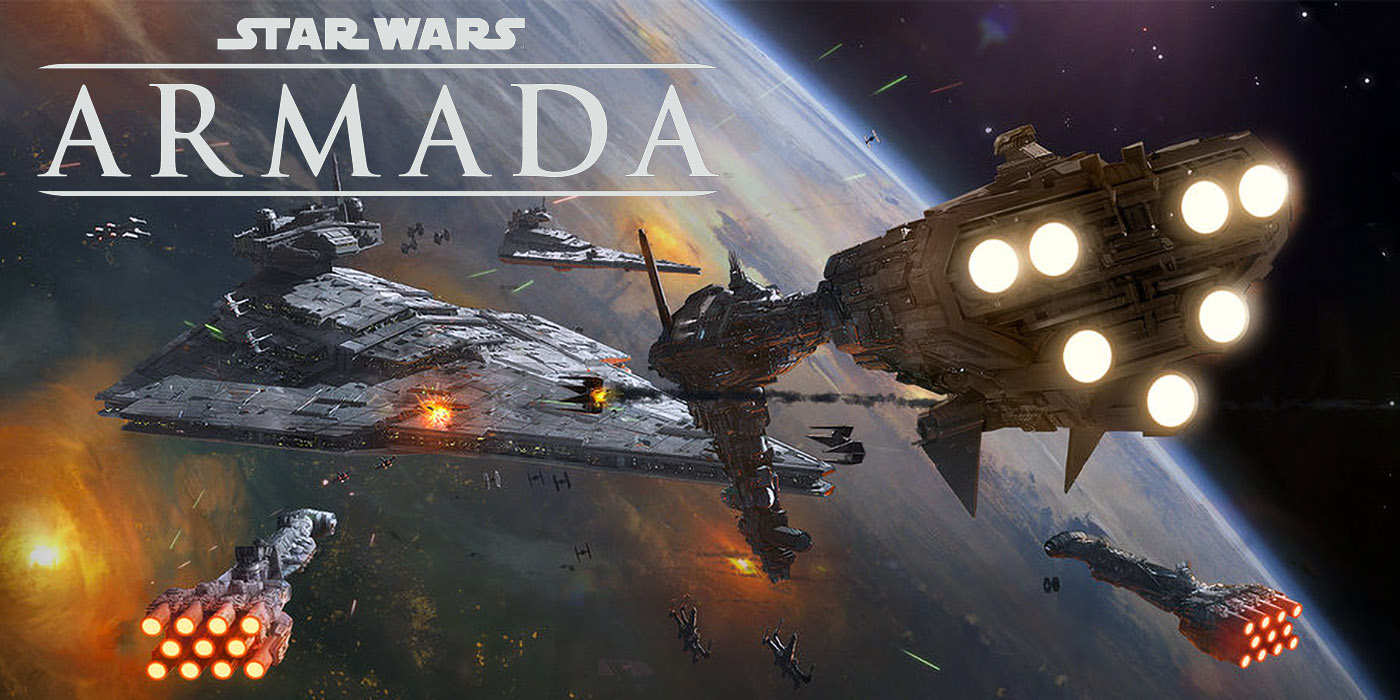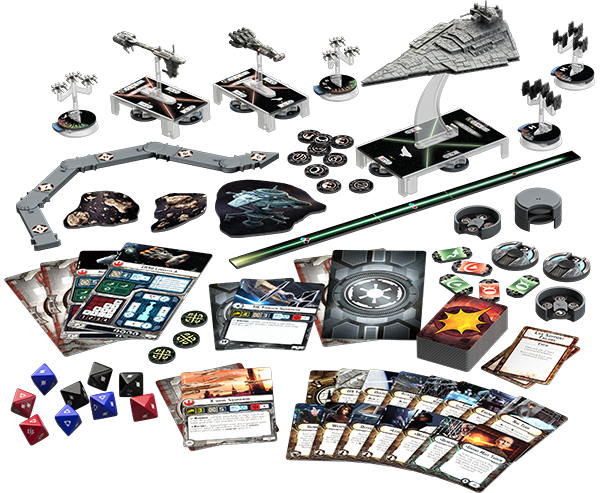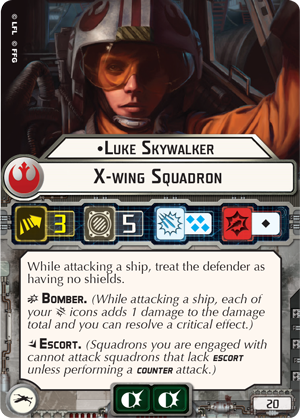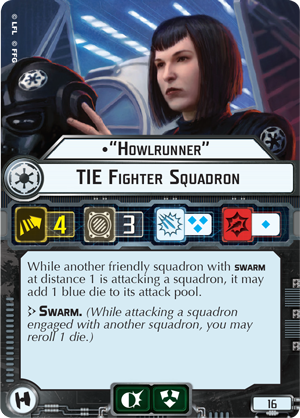STAR WARS ARMADA – First Impressions


Today we get the first impressions of a long time 40K gamer and occasional X-Wing player on the latest offering from Fantasy Flight Games.
A guest review by Apone848
Since it’s release, I’ve managed to play 3 games of the new Star Wars – Armada game. What follows are the first impressions of a long time 40K gamer and occasional X-Wing player on the latest offering from Fantasy Flight Games.
First thought?
It feels like a $50 game in a $100.
The Pros
To begin, what I like about it:
The Commands system for the capital ships. It forces you to think ahead, plan for expected engagements, and use your resources as a fleet, vice individual ships.
The Engineering Commands’ ability to automatically repair your ships without having to resort to dice tests is an elegant mechanic – its limited to set levels of repair by ship, modifiable to a limited extent, but doesn’t rely on the vagaries of chance. I think it neatly captures the realities of trained crew without creating a panacea (*even the 3 Engineering points of a Star Destroyer for example, cannot outstrip the potential damage of a single turn’s shooting, but over time, will quickly restore that vessel to full working order).
Command Tokens: An interesting mechanic that builds a layer of flexibility into the game without unhinging the Command Dial mechanic. If, for example, you’re not ‘doing anything’ beyond moving and shooting in a given turn (for example, as you maneuver into position before you lock S-foils and begin your attack run), you can choose to convert your Command Dials to tokens to save for a lesser effect in later turns. This means you can store up multiple bonus effects – and use then burn them all as needed in subsequent turns (including all at once) to really go over the top and press your attack or execute a daring maneuver, etc. In particular, this provides the Imperials a balancing mechanism of sorts against the ‘I react every turn’ nature of the smaller, faster ships of the Rebel Fleet. Case in point, a movement dial converted to a movement token lets you execute tighter turns, or speed up/down when you might otherwise be focused on shooting or engineering. This means a more cumbersome Star Destroyer that needs to turn that extra notch to line up an attack on a more agile Corvette can do so (with proper planning, which again speaks to the think ahead nature of the game).
The Defenses mechanisms allowed in the ships – the combinations of shields, bracing for impact, and evade – makes for an interesting mechanism that blunts much of the damage a ship might otherwise suffer. Hence, ships can be more survivable than you’d expect – yet still very vulnerable if poorly maneuvered or confronted with Accuracy dice. All in all, it’s much cleaner to use than the damage tables of a game like Battlefleet Gothic (* I’ve no experience with Firestorm Armada, so I can’t compare it to that system).
The Maneuver System is a little wonky at first with its bendable measurement stick, clicks, and oddly marked ‘clicks on the dial’ notations on the cards, but once you’ve got the hang of it, it’s easy and readily captures the feel of ships trying to move in time and space (*albeit in two dimensions). And while its much less complex than the maneuver dials of X-Wing, maneuver is very much the heart of the game and the bendable measuring stick creates an excellent sense of momentum and the challenges of maneuvering.
And both fleets have their challenges. Where the Imperials tend to lumber forward, the faster Rebel fleet takes a good deal of finesse to ensure they go where you need them to be in good order. In my first game (on a 3×3 space) I promptly ran a Nebulon B off the board edge – and my opponent did as well with his Star Destroyer. In my third game, my attempt to spread my fleet and then move quickly to concentrate on my opponent’s left put my Nebulon B Frigate squarely in his front firing arc, which soon saw it destroyed. By contrast, the Corvettes, particularly when armed with Maneuver Tokens are very agile and I ran them around quite neatly, threading through asteroids and other ships quite neatly.
I also learned a good deal about Ramming, namely don’t try to stop if you can’t avoid another ship, because the rules aren’t written to make you come to a dead stop. Use your speed tokens to speed up to get clear the following turn, because you just take damage and then pop out the other side if you can in the next turn … so if you’re going to overlap, don’t try to slow down … just put your shoulder into it and press on. Squadrons: Very flexible if properly resourced (*with the ‘Squadrons’ Command, they can move AND shoot – otherwise, it’s just one or the other, which leaves the vulnerable); suitably dangerous to smaller ships; and adequately ‘defended’ from attacks by virtue of how the dice roll (i.e.: critical hits and target results don’t count as hits, so there’s a lot of room to miss when shooting at them).
TIE Fighters in large numbers are, as I’d expected after my first two games, dangerous. In our third game, my opponent had 11 stands of them (within the legal 30% limit in Fleet Building Rules for a 300 point game), and used them quite effectively to strip the shields from my ships and set up one of my ships for a kill shot. You still need Squadron activation commands to make the most of them, but properly supported, they’ve pretty dangerous. It will be interesting to see how many ‘Squadron’ points other ships get – whether either fleet will receive a ‘carrier’ at some point to maximize their use of squadrons.
By contrast, X-Wings make better for a anti-air defense than any rebel ship is capable of putting out, but at 13 points each they’re not a cost-effective way to defend against 8 point TIE squadrons. That said, their Bomber Rule (*which means your critical hits cause damage) is nasty. And while Luke Skywalker costs 20 points for his squadron he rolls a black die that ignores shields, which means that can will hurt you badly if let him get into Range 1.
I know there’s an effect on squadrons related to ‘being engaged’ that we didn’t account for in this first couple games – but my suspicion is that the Rebels will suffer for that rule, because they can’t match the Imperials for numbers. So it will be interesting to see what comes out with the B-Wings and A-Wings. And God help us when the TIE Interceptors show up.
Grand Moff Tarkin is a helluva force multiplier. Every turn he can give tokens to your entire fleet. Expensive in a 2-3 ship fleet at 38 points, but will be well worth it when they release smaller Imperial ships (i.e.: when you can have more of them that don’t cost 75pts each).
Initiative really matters: Going first means that you can set your ships up to shoot and scoot because you fire first. Especially useful for the more agile Rebel Fleet. So game your list building to exploit that – don’t go for 300pts when 295pts will get you the first turn.
Free Rules: FFG has done a great service to the community by putting their rule sets online. Unlike some other companies (ahem, talking to you, Mr. $80 BRB), FFG understands that the best way to sell models is to get folks excited about the game.
The Cons
But all that said, here’s what I am concerned with …
From a maneuver perspective, the proposed 3×6 space will, I think, restricts the movement of the Star Destroyers. To remain on the board they really need to slow down and do laps … which takes the maneuver out of the game (*and as an occasional X-Wing player, that’s been something that I’ve always considered essential to the spirit of these games).
This obviously isn’t dog fighting on that scale, but to succeed in the long run, the game needs to be more than just the Rebels doing laps around the lumbering Star Destroyers. I suspect that this problem will resolve itself to some extent with larger fleets and larger playing spaces. And Speed 0 ships lose all their Defense Mechanics, but it could still be challenging for the Rebels.
By contrast, in our third game we tried a 4×5 space and both really enjoyed it for the running room it gave the Rebels, and the defense in depth space it allowed the Imperials. As always, House Rules have their place.
The Star Destroyer, by virtue of its heavy armaments, high hull value, and 4 Engineering tokens has the possibility to simply ‘castle up’ in the corners or near the board edges, thereby denying the Rebels their key strength – agility. This means they’ll need to slug it out with the Imperials, which they really can’t do with the current ships available. This will be especially true if the Imperial player keeps his fleet together where they can support one another.
Building on that, 6 game turns is far too short. Easily discarded, but I can see it becoming a factor in tournament play. When we did discard it, we had a lot more fun. But without it, I am not sure the Rebels can really go toe to toe.
Multiple ships and a bigger play space make for more fun. I eventually got behind one of the Star Destroyers – and was never really going to be out of position at that point — but my opponent would have been able to bring his other ship to bear to block the move if we’d gone into more turns. Regardless, that wouldn’t have been possible on the more constrained 6×3. (*as I said, we played on a 4×5 space). All in all, though, I think the standard 6×4 mats we all own for games like 40K will be pretty great for playing on, even if they’re not regulation standard.
The Maneuver Tool feels cheap … expect it to break, and expect to buy an after-market model one too.
So do the Fighter Squadrons. Set against the high quality of the capital ships, the fighters that sit atop the squadron stands look like they come from the travel edition of Risk.
Which brings us to what I see as the critical fault with the game – Star Wars Armada is too expensive.
At $100 for the starter set (or $75 on sites like Warstore and Amazon) it’s double or triple what the X-Wing starter set was – but doesn’t give you any more game. It’s still just three capital ships – which is what the game is really about. The ample supply of squadrons is nice, but they typically won’t carry the day in terms of who actually wins the game.
Most of us purchased multiple copies of the X-Wing starter set to build out our core sets. At $100, however, this isn’t really much of an option – particularly for the Rebel faction, where those two extra little capital ships don’t buy you any significant increases in firepower or survivability. It’s not until you’re down into the $60 price range offered by Walmart.com that you stop feeling like getting a proton torpedo in your exhaust port. And even then that’s still double the cost of the X-Wing starter set online.
So what, right? It’s still a fun game, right?
Of course it is!
But …
… this means that would-be players will need to be far more selective in which of the Wave 2, Wave 3, etc ships of the subsequent releases they buy to build out their fleets. And at $30 and up for the bigger ships, buying those ships will be a more selective prospect than doing so under the price points of the the X-Wing fleet expansion model. With Armada, those high prices make much harder to justify just picking up an extra ship to see what cards it might contain.
Of course, there will be cheaper online options for these ships; you can already see some of those in the pre-orders available (*just look at Walmart’s $60 offering, for example)
The high costs of buying the new ships will dampen the ‘impulse buy at the FLGS’ factor. Armada’s ships are two to three times more expensive than those used in X-Wing … and you’re still just getting a tiny little piece of painted plastic and a few cards.
It’s literally the same amount of treat in a bigger box.
Rather than make the ships cost fewer points each to sell more of them and set up larger fleet battles, FFG is instead pursuing a pricing model that recalls GW’s approach – mark up a few key elite items and let the consumer deal with the consequences.
It’s unclear, for example, what’s gained by having a 300pt game have just 3 Star Destroyer at a minimum of 77pts /$40 each, versus larger fleet actions of 9 Star Destroyers costing 25pts / $15 each. The latter would cleave more to the BFG / Firestorm model of true fleet actions … whereas Armada looks to be more about a few great ships slugging it out amidst swarms of fighters.
This makes me think it’d be better to wait to see if you really need that ship … and then get it online because it’s just too expensive not to. Why, for example, give your FLGS (or Barnes and Noble, that great stalwart of propagating X-Wing) $40 of your money for a new Star Destroyer when you can get it for $25 online?
And that’s a disservice to the very people that helped make X-Wing so popular.
That Said…
All this said, these are my thoughts after just three games. I’m still intrigued to see what new ships, different fleets, different play spaces, and modification cards will bring to the game. It’s not X-Wing, and it’s not going to be. But it’s definitely overpriced.
What do you think of Armada’s gameplay and pricepoint?




